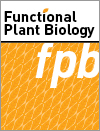
Functional Plant Biology
Volume 48 Number 1 2021
The hot issue is the TOR signalling network in plants. In the context of plants, we discuss the TOR complex, the TOR signalling network, glucose–TOR signalling, TOR-SnRKs signalling pathway as well as the unknown functions of TOR. Recent studies have revealed that TOR plays various functions in the development of plants, and there is work to be done to answer questions about TOR proteins in plants.
FP19356Salt induced programmed cell death in rice: evidence from chloroplast proteome signature
Salt concentration in the soil is an important factor determining a plant’s survival and productivity. High salt concentration kills the plant whereas moderate salt induces significant reorganisation of cellular metabolism leading to programmed cell death (PCD). In plant cells, chloroplasts are highly sensitive to salt, so play an important role in salt-induced PCD by modulating protein content. Here we characterised and identified some potential candidates from the chloroplast proteome of 10-day-old rice seedlings before the time point where the signature of PCD was observed.
The water content in the seed banks represents an important factor in the regulation of several processes together temperature such as seed dormancy changes, germination and seedling emergence. However, there is little information on how these processes are regulated under field conditions. We demonstrate that seed water content is instrumental for the perception of environmental signals (i.e. temperature) that allow the adjustment of the emergence timing to the seasonality that characterises temperate habitats.
The simultaneous effects of methyl jasmonate as a simulative effector of plant secondary metabolism and different carbon sources were studied here for the first time. Increased carbohydrate concentrations and replacement of sucrose with sorbitol impose stressful conditions and induced antioxidant potential, production of medicinal alkaloids and activation of regulatory genes (CrMAPK3, ORCA3), and biosynthetic enzymes (CrPRX1, STR, DAT, GS). Expressing the relationships between alterations in gene expression and the production of TIA alkaloids could enhance the comprehension of the whole interplay and regulations.
FP20028Identification of conserved genes linked to responses to abiotic stresses in leaves among different plant species

Because of global climate change, certain stress factors that have a negative impact on crop productivity such as heat, cold, drought and salinity are becoming increasingly prevalent. We conducted a meta-analysis to identify genes conserved across plant species involved in: (1) general abiotic stress conditions, and (2) specific and unique abiotic stress factors (drought, salinity, extreme temperature) in leaf tissues. The findings of this work will allow the identification of new molecular markers conserved across crops linked to major genes involved in quantitative agronomic traits affected by climate change.
Rice is staple crop for the human population the world over, but its production is greatly affected by increasing salinisation of agricultural land. Hence, this paper focussed on understanding the salt tolerance determinants in the species, and exclusion of Na+ was found to be the primary mechanism governed by SOS1/PM-H+ATPase module. Therefore, attempts to increase salt tolerance in the rice cultivar of interest should target exclusion of Na+, primarily by manipulation of the efficiency of SOS1/PM-H+ATPase functioning.
Pathogen-induced metabolites enhance resistance to various plant diseases and the degree of resistance in plants can be explained based on the functionality of resistance related metabolite biosynthetic genes. Deleterious mutations in these R genes in Russet Burbank potato cultivar were identified based on RNA sequencing. These deleterious mutations can be edited to enhance late blight resistance.
FP19278Glucosinolate profile and Myrosinase gene expression are modulated upon Plasmodiophora brassicae infection in cabbage

Clubroot is a devastating disease of Brassicaceae caused by the biotrophic protist Plasmodiophora brassicae. We found two BolMyro and 12 BolMBP genes were highly expressed in the susceptible line, whereas only one BolMyro and five BolMBP genes were highly expressed in the resistant line. Our results provide insights into the roles of Myro and MBP genes in GSL hydrolysis during P. brassicae infection, which will help for developing clubroot resistant cabbage lines.



